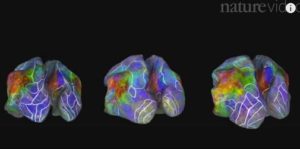
For an explanation of the featured image, above, see page 4 of this article.
Image from Nature Youtube Video on page 3: Three different brains map the same word meanings to similar locations

Berkeley scientists disclose success in mapping semantic areas of the brain.
Scientific advancement has a way of accelerating in an age where advancements in one area of science or technology precipitate advances in another area. In April, 2016, a group of scientists at the University of California at Berkeley, disclosed their success in mapping the brain for semantics. They found regions of the brain which, across a spectrum of individuals, were activated by groups of words with similar meanings.
The experiment, limited as it was to semantics and words, is differentiated from other brain mapping experiments where test subjects have been shown movies, with an attempt to recreate the movie by reading the resulting brain imagery derived from watching the movie.
The experiment is also differentiated from experiments which have identified isolated parts of the brain involved in muscular movement. Such experiments have helped paralyzed individuals to learn to move a cursor on a computer screen by imagining muscular movement, translatable to robotic movement.
The semantic brain map study ruled out visual images by asking individuals to listen to a radio broadcast from The Moth Radio Hour, a radio broadcast with an internet presence, wherein individuals narrate brief, personal stories, much like a TED talk, but with some stories being as short as around 3 minutes.
Scientists familiar with the theory of right-brain (math, art), left-brain (language) specialization were interested to see that areas in both lobes of the brain respond similarly to language.
Alex Huth, Jack Gallant and colleagues set out to map the functional representations of semantic meaning in the human brain using voxel-based modelling of functional magnetic resonance imaging (fMRI) recordings made while subjects listened to natural narrative speech. -Extract from Editor’s Summary
Researchers at the University of California – Berkeley studied the brains of seven native English speakers as they listened to a podcast of the Moth Radio Hour. Then, they mapped out which areas of the brain lit up in response to hearing different words in different contexts.
They found that words are grouped in certain areas of the brain based on their relative meanings, and they also discovered where these groups are housed.
For example, in the right temporal parietal junction, in an area a few millimeters in width, words like “wife,” “pregnant,” and “mother” were processed, and an area just adjacent to it processed some of the same social words, as well as some related ones having to do with people and places, such as “house” and “owner.”
“The similarity in semantic topography across different subjects is really surprising,” said study lead author Alex Huth, a postdoctoral researcher in neuroscience at UC Berkeley, in a press release.
It’s a potential breakthrough for people who have lost the ability to speak. If scientists are able to map out where the brain processes words – and that map is relatively uniform – they may be able to help people suffering from ALS or victims of stroke be understood through technology.
In visiting the source article at US News.com, although only the abstract is free, the more valuable portions of the study are found at the bottom of the 38-article bibliography.
These bottom links will take you to the BRAIN MAPS. These links are well worth a visit.
What has enabled this brain mapping work at this time, technologically speaking? Much work imaging the brain has been made possible by Functional Magnetic Resonance Imaging (fMRI) technology, for which we will provide a bit of history in the subsequent pages.
Also important is the 3-dimensional Voxel, a counterpart to the 2-dimensional Pixel used in web page renderings.
To set this study in the context of these technologies, visit the next page.



